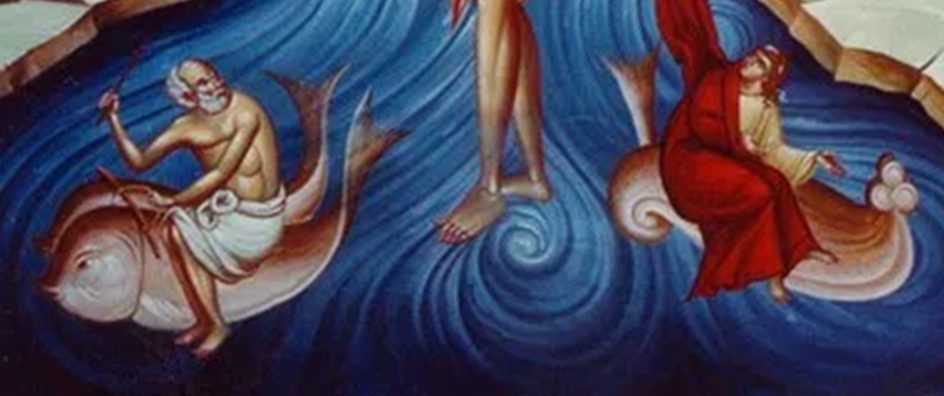The word Theophany originates from two Greek words, Theos – God, and Phainein – showing. Therefore, it literally means a “revelation of God” in Greek (Θεοφάνεια). This event is the first revelation of the Trinity in the life of Christ. Jesus Christ; God become a man; the Messiah is central to the icon. The semi-circle at the top of the Icon symbolizes heaven from which comes the voice of God the Father. The Father expresses His pleasure in His Son: This is my Son, the Beloved, with whom I am well pleased. Mt 3:17. From the Father comes forth the Spirit of God which descends like a dove and alights upon Him. Mt 3:16.
There is a significance to the mountains in the background. We know from the Old Testament that mountains are a place of encounter with God (Abraham, Moses etc.). Here the mountains witness to a divine encounter at this moment. It is as if they are reaching toward the centre of the icon where the Trinity is revealed. Through this, we understand that all of the creation bows down to God.
Jesus, the Messiah is easily identifiable by the nimbus (halo) surrounding the His head bearing a cruciform containing the Greek letters omikron, omega, nu – “I am He who is” the name of God in Ex 3:14. Outside the nimbus (halo) are the Greek letters IC XC – the Christogram. In icons of the Theophany, Christ is depicted either completely naked or minimally clothed. He is the second Adam (1 Cor 15). In shame, the first Adam hid from God in his nakedness. Christ, who is both God and man, is unashamed. In Him we see the beauty of undefiled humanity. As He submits to John’s baptism, it is the Messiah that in actuality sanctifying the world. Note that His hand is in a sign of blessing. Unlike our baptism where the waters cleanse us of our sins, here, it is Christ Who cleanses and sanctifies the waters. All of creation is baptized at this moment.
In this event is a meeting of heaven and earth as evidenced by the opening of heaven and the presence of the angels. Christ in the middle is that bridge between the two. We are reminded that icons reveal not simply the physical but the spiritual reality. The angels are not mentioned in the accounts of this event, but we know that they are there, ready to attend to Him. Their hands are veiled, depicting their reverence for Him whom they serve. They are in awe that He has condescended to submit to this Baptism. We read about this in the hymnography of the feast: The angels, beholding Him, were afraid: heaven was filled with wonder and the earth shook. (Sessional Hymn, Kathisma 3 & Small Litany)

Although this particular icon does not show them, at the bottom of many Theophany Icons, there are small creatures which appear to be fleeing from Christ. They represent the Jordan river and the Red sea as we read in Scripture: The sea saw and fled, the Jordan turned back Ps114:3.
Christ God, the creator of all that is, stands in His creation and creation recognizes Him as reflected in the Psalms: You divided the sea by your might; you broke the heads of the dragons in the waters. Ps 74:13.
When the waters saw you, O God, when the waters saw you, they were afraid; the very deep trembled. Ps 77:16
It is significant that John stands at the right hand of Christ where the prophet Elijah stands in the icon of the transfiguration on Mount Tabor. This links the first great theophany in the life of Christ to that which occurs in the transfiguration. As do all the prophets, the lives of both Elijah and John ultimately point us to Christ. John bows to Jesus, the one who he is baptizing but who, in reality, baptizes the whole world. In many icons of the Theophany John’s gaze is directed in awe toward the revelation of the Triune God. He recognizes who stands before him. Jesus the Christ, one in the Holy Trinity.
We recall that it was the Jordan river that, enabled by God, the People of God crossed, moving from East to West. Thus, they entered into the promised land and God’s covenant with His people was fulfilled. In the icon, John stands on the west side of the river (earth) and the angels on the east (heaven). In this event, Christ initiates a movement from the west to the east; from the old covenant to the new; from the old, promised land to the new, promised land.
There is a tree below John which bears an ax. This reflects what John has been teaching. Even now the ax is lying at the root of the trees; every tree therefore that does not bear good fruit is cut down and thrown into the fire. Mt. 3:10. All the baptized are continually called to repentance and to bear fruit for the Kingdom of God. As part of the new covenant, the faithful are not made sons and daughters of God by their ancestral heritage but by their response to God’s calling and the fulfillment of their baptismal promises. Therefore, this feast reminds us of our own baptismal promises and urges us not to become spiritually lazy but to work to fulfill them.
Compiled & created by the Religious Education Department of the Ukrainian Catholic Eparchy of Edmonton: http://eeparchy.com/ Permission granted to reproduce for personal and classroom use. 2020.

